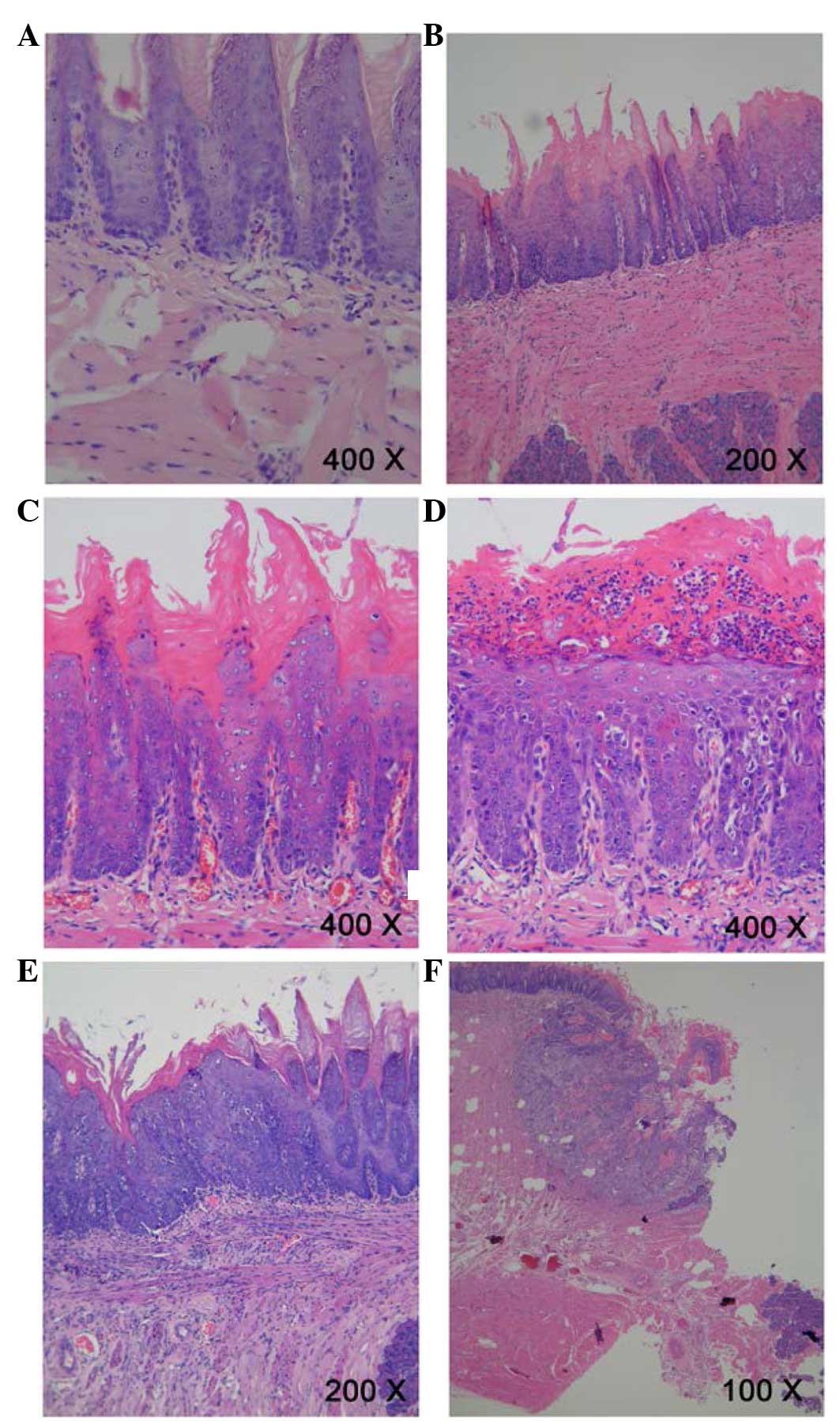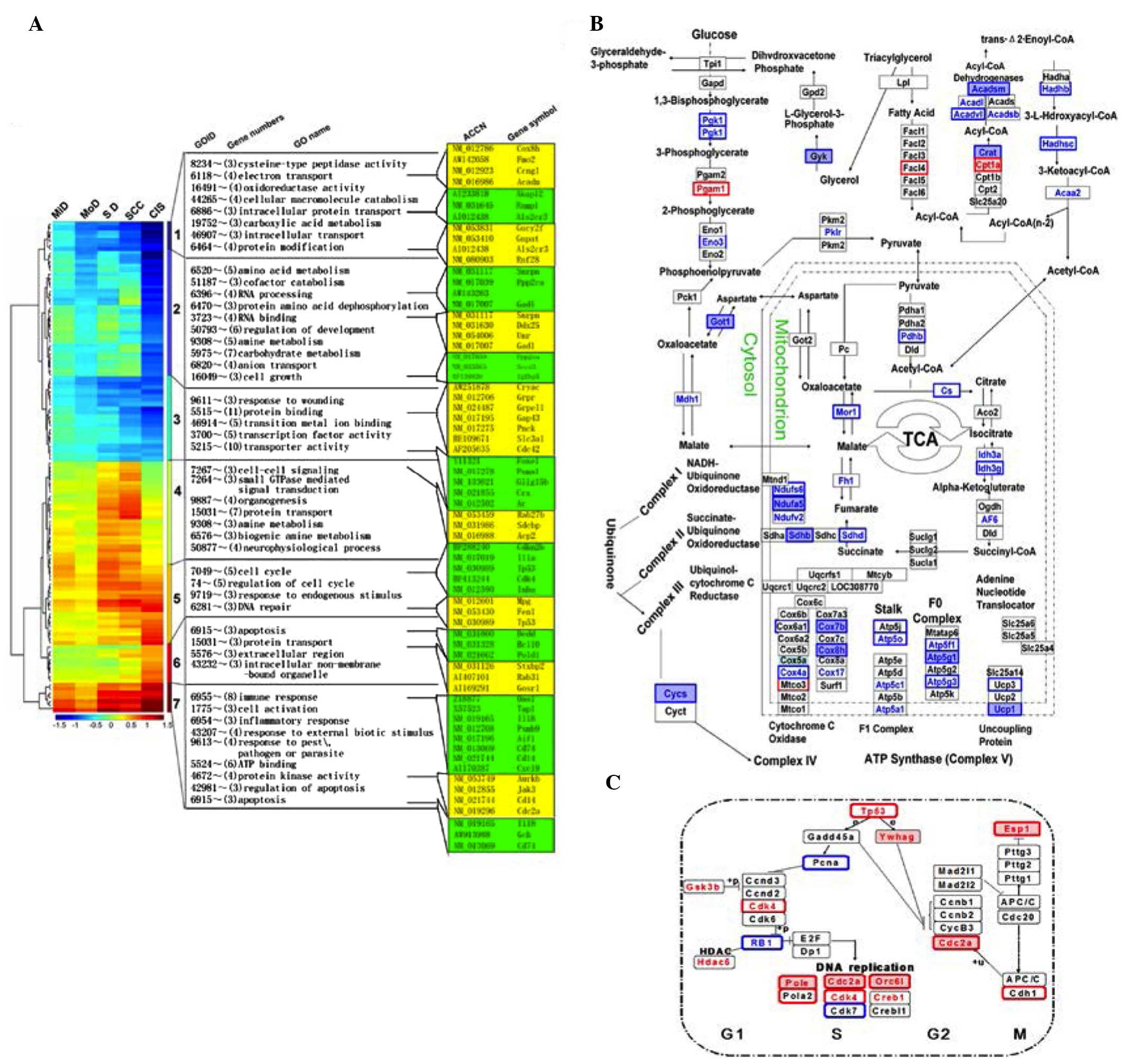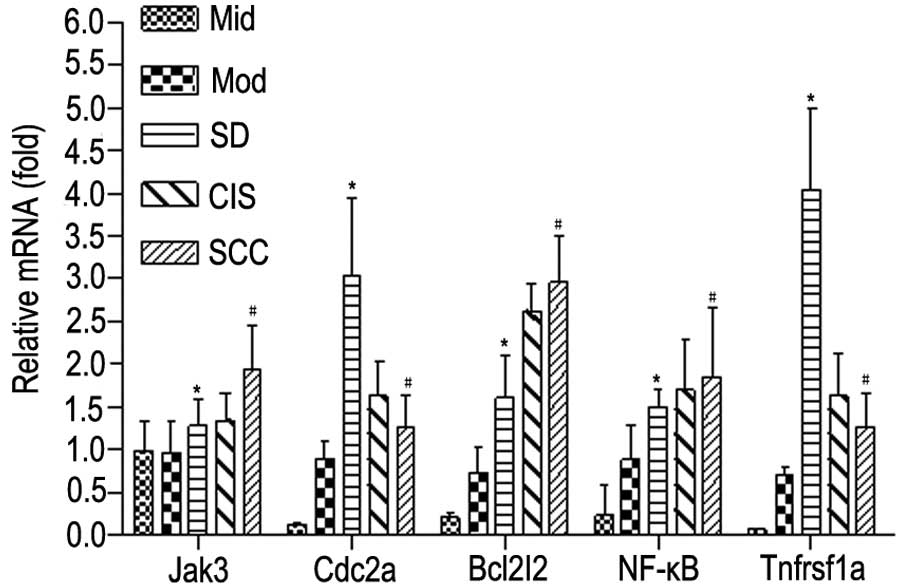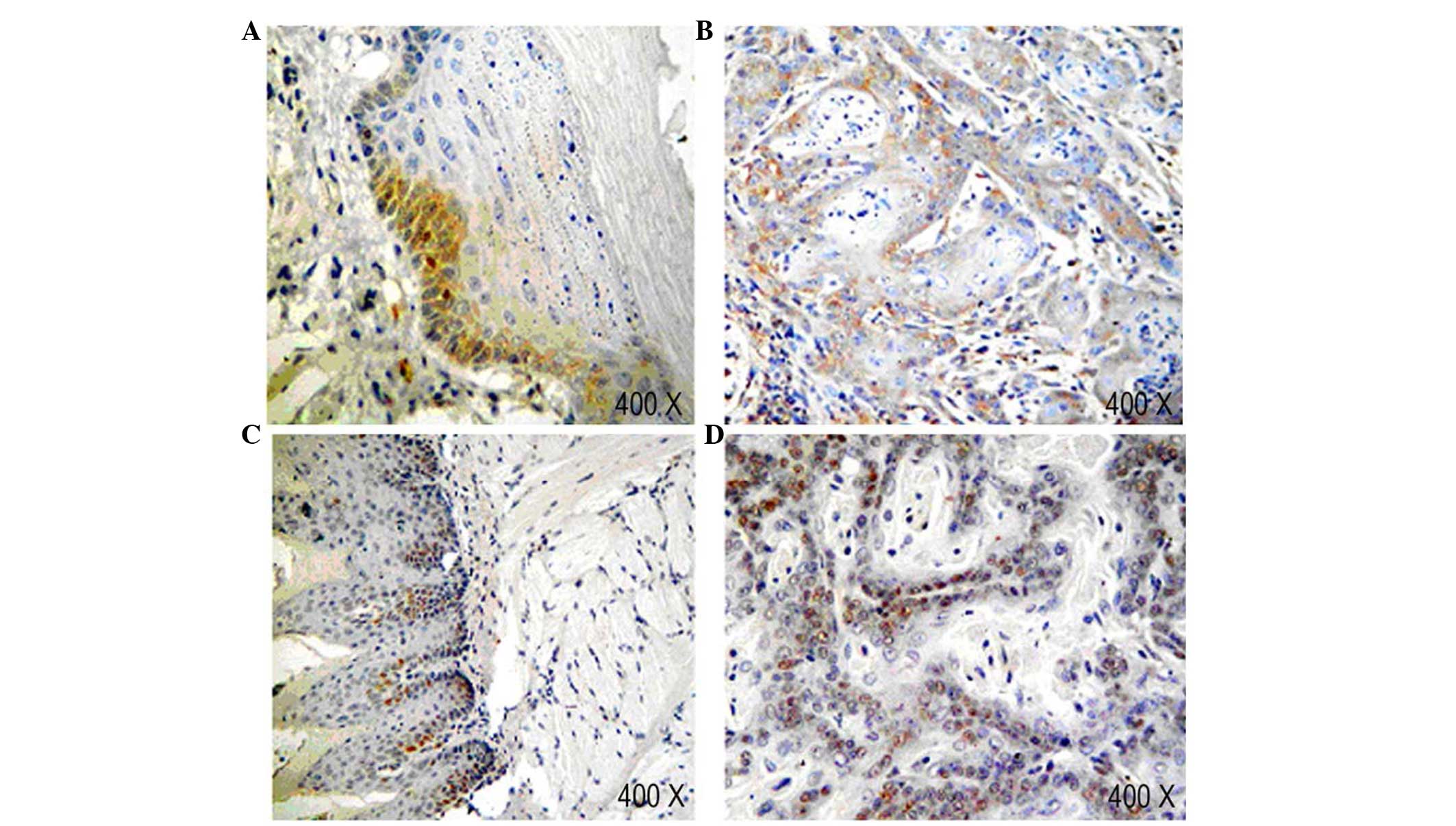|
1
|
Ferlay J, Bray F, Parkin DM and Pisani P:
Globocan 2000: Cancer Incidence and Mortality Worldwide. (IARC
Cancer Bases No. 5). IARCPress; Lyon: 2001
|
|
2
|
Warnakulasuriya S: Global epidemiology of
oral and oropha-ryngeal cancer. Oral Oncol. 45:309–316. 2009.
View Article : Google Scholar
|
|
3
|
Kademani D, Bell RB, Schmidt BL,
Blanchaert R, Fernandes R, Lambert P and Tucker WM; American
Association of Oral and Maxillofacial Surgeons Task Force on Oral
Cancer: A preliminary report from the American Association of Oral
and Maxillofacial Surgeons Task Force on Oral Cancer. J Oral
Maxillofac Surg. 66:2151–2157. 2008. View Article : Google Scholar : PubMed/NCBI
|
|
4
|
Ram H, Sarkar J, Kumar H, Konwar R, Bhatt
ML and Mohammad S: Oral cancer: Risk factors and molecular
pathogenesis. J Maxillofac Oral Surg. 10:132–137. 2011. View Article : Google Scholar :
|
|
5
|
Williams H: Molecular pathogenesis of oral
squamous carcinoma. Mol Pathol. 53:165–172. 2000. View Article : Google Scholar : PubMed/NCBI
|
|
6
|
Nagpal JK and Das BR: Oral cancer:
Reviewing the present understanding of its molecular mechanism and
exploring the future directions for its effective management. Oral
Oncol. 39:213–221. 2003. View Article : Google Scholar : PubMed/NCBI
|
|
7
|
Shaw R: The epigenetics of oral cancer.
Int J Oral Maxillofac Surg. 35:101–108. 2006. View Article : Google Scholar
|
|
8
|
Scully C, Field JK and Tanzawa H: Genetic
aberrations in oral or head and neck squamous cell carcinoma
(SCCHN): 1. Carcinogen metabolism, DNA repair and cell cycle
control. Oral Oncol. 36:256–263. 2000. View Article : Google Scholar : PubMed/NCBI
|
|
9
|
Todd R, Chou MY, Matossian K, Gallagher
GT, Donoff RB and Wong DT: Cellular sources of transforming growth
factor-alpha in human oral cancer. J Dent Res. 70:917–923. 1991.
View Article : Google Scholar : PubMed/NCBI
|
|
10
|
Partridge M, Gullick WJ, Langdon JD and
Sherriff M: Expression of epidermal growth factor receptor on oral
squamous cell carcinoma. Br J Oral Maxillofac Surg. 26:381–389.
1988. View Article : Google Scholar : PubMed/NCBI
|
|
11
|
McDonald JS, Jones H, Pavelic ZP, Pavelic
LJ, Stambrook PJ and Gluckman JL: Immunohistochemical detection of
the H-ras, K-ras, and N-ras oncogenes in squamous cell carcinoma of
the head and neck. J Oral Pathol Med. 23:342–346. 1994. View Article : Google Scholar : PubMed/NCBI
|
|
12
|
Williams HK, Sanders DS, Jankowski JA,
Landini G and Brown AM: Expression of cadherins and catenins in
oral epithelial dysplasia and squamous cell carcinoma. J Oral
Pathol Med. 27:308–317. 1998. View Article : Google Scholar : PubMed/NCBI
|
|
13
|
Ravi D, Ramadas K, Mathew BS, Nalinakumari
KR, Nair MK and Pillai MR: De novo programmed cell death in oral
cancer. Histopathology. 34:241–249. 1999. View Article : Google Scholar : PubMed/NCBI
|
|
14
|
Duggan DJ, Bittner M, Chen Y, Meltzer P
and Trent JM: Expression profiling using cDNA microarrays. Nat
Genet. 21(Suppl): 10–14. 1999. View
Article : Google Scholar : PubMed/NCBI
|
|
15
|
Kuo WP, Whipple ME, Sonis ST, Ohno-Machado
L and Jenssen TK: Gene expression profiling by DNA microarrays and
its application to dental research. Oral Oncol. 38:650–656. 2002.
View Article : Google Scholar : PubMed/NCBI
|
|
16
|
Hwang D, Alevizos I, Schmitt WA, Misra J,
Ohyama H, Todd R, Mahadevappa M, Warrington JA, Stephanopoulos G,
Wong DT and Stephanopolus G: Genomic dissection for
characterization of cancerous oral epithelium tissues using
transcription profiling. Oral Oncol. 39:259–268. 2003. View Article : Google Scholar : PubMed/NCBI
|
|
17
|
Alevizos I, Mahadevappa M, Zhang X, Ohyama
H, Kohno Y, Posner M, Gallagher GT, Varvares M, Cohen D, Kim D, et
al: Oral cancer in vivo gene expression profiling assisted by laser
capture microdissection and microarray analysis. Oncogene.
20:6196–6204. 2001. View Article : Google Scholar : PubMed/NCBI
|
|
18
|
Tang XH, Knudsen B, Bemis D, Tickoo S and
Gudas LJ: Oral cavity and esophageal carcinogenesis modeled in
carcinogen-treated mice. Clin Cancer Res. 10:301–313. 2004.
View Article : Google Scholar : PubMed/NCBI
|
|
19
|
Kramer IR, Lucas RB, Pindborg JJ and Sobin
LH: Definition of leukoplakia and related lesions: An aid to
studies on oral precancer. Oral Surg Oral Med Oral Pathol.
46:518–539. 1978. View Article : Google Scholar : PubMed/NCBI
|
|
20
|
Horcajadas JA, Sharkey AM, Catalano RD,
Sherwin JR, Domínguez F, Burgos LA, Castro A, Peraza MR, Pellicer A
and Simón C: Effect of an intrauterine device on the gene
expression profile of the endometrium. J Clin Endocrinol Metab.
91:3199–3207. 2006. View Article : Google Scholar : PubMed/NCBI
|
|
21
|
Xiao L, Wang K, Teng Y and Zhang J:
Component plane presentation integrated self-organizing map for
microarray data analysis. FEBS Lett. 538:117–124. 2003. View Article : Google Scholar : PubMed/NCBI
|
|
22
|
Dennis G Jr, Sherman BT, Hosack DA, Yang
J, Gao W, Lane HC and Lempicki RA: DAVID: Database for annotation,
visualization, and integrated discovery. Genome Biol. 4:32003.
View Article : Google Scholar
|
|
23
|
Livak KJ and Schmittgen TD: Analysis of
relative gene expression data using real-time quantitative PCR and
the 2−ΔΔCt method. Methods. 25:402–408. 2001. View Article : Google Scholar
|
|
24
|
Evan GI and Vousden KH: Proliferation,
cell cycle and apoptosis in cancer. Nature. 411:342–348. 2001.
View Article : Google Scholar : PubMed/NCBI
|
|
25
|
Smith BD and Haffty BG: Molecular markers
as prognostic factors for local recurrence and radioresistance in
head and neck squamous cell carcinoma. Radiat Oncol Investig.
7:125–144. 1999. View Article : Google Scholar : PubMed/NCBI
|
|
26
|
Quelle DE, Ashmun RA, Shurtleff SA, Kato
JY, Bar-Sagi D, Roussel MF and Sherr CJ: Overexpression of mouse
D-type cyclins accelerates G1 phase in rodent fibroblasts. Genes
Dev. 7:1559–1571. 1993. View Article : Google Scholar : PubMed/NCBI
|
|
27
|
Miyamoto R, Uzawa N, Nagaoka S, Hirata Y
and Amagasa T: Prognostic significance of cyclin D1 amplification
and overexpression in oral squamous cell carcinomas. Oral Oncol.
39:610–618. 2003. View Article : Google Scholar : PubMed/NCBI
|
|
28
|
Robinson CM, Prime SS, Huntley S, Stone
AM, Davies M, Eveson JW and Paterson IC: Overexpression of JunB in
undifferentiated malignant rat oral keratinocytes enhances the
malignant phenotype in vitro without altering cellular
differentiation. Int J Cancer. 91:625–630. 2001. View Article : Google Scholar : PubMed/NCBI
|
|
29
|
Cheng YH, Li LA, Lin P, Cheng LC, Hung CH,
Chang NW and Lin C: Baicalein induces G1 arrest in oral cancer
cells by enhancing the degradation of cyclin D1 and activating AhR
to decrease Rb phosphorylation. Toxicol Appl Pharmacol.
263:360–367. 2012. View Article : Google Scholar : PubMed/NCBI
|
|
30
|
Wilson GD, Saunders MI, Dische S, Richman
PI, Daley FM and Bentzen SM: bcl-2 expression in head and neck
cancer: An enigmatic prognostic marker. Int J Radial Oncol Biol
Phys. 49:435–441. 2001. View Article : Google Scholar
|
|
31
|
May MJ and Ghosh S: Signal transduction
through NF-kappaB. Immunol Today. 19:80–88. 1998. View Article : Google Scholar : PubMed/NCBI
|
|
32
|
Tracey L, Streck CJ, Du Z, Williams RF,
Pfeffer LM, Nathwani AC and Davidoff AM: NF-kappaB activation
mediates resistance to IFNbeta in MLL-rearranged acute
lymphoblastic leukemia. Leukemia. 24:806–812. 2010. View Article : Google Scholar : PubMed/NCBI
|
|
33
|
Shostak K and Chariot A: NF-κB, stem cells
and breast cancer: The links get stronger. Breast Cancer Res.
13:2142011. View
Article : Google Scholar
|
|
34
|
Fan Y, Mao R and Yang J: NF-κB and STAT3
signaling pathways collaboratively link inflammation to cancer.
Protein Cell. 4:176–185. 2013. View Article : Google Scholar : PubMed/NCBI
|
|
35
|
Thu YM, Su Y, Yang J, Splittgerber R, Na
S, Boyd A, Mosse C, Simons C and Richmond A: NF-κB inducing kinase
(NIK) modulates melanoma tumorigenesis by regulating expression of
pro-survival factors through the β-catenin pathway. Oncogene.
31:2580–2592. 2012. View Article : Google Scholar :
|
|
36
|
Nakayama H, Ikebe T, Beppu M and Shirasuna
K: High expression levels of nuclear factor kappa-B, IκB kinase α
and Akt kinase in squamous cell carcinoma of the oral cavity.
Cancer. 92:3037–3044. 2001. View Article : Google Scholar : PubMed/NCBI
|
|
37
|
Arnott CH, Scott KA, Moore RJ, Hewer A,
Phillips DH, Parker P, Balkwill FR and Owens DM: Tumour necrosis
factor-alpha mediates tumour promotion via a PKC alpha- and
AP-1-dependent pathway. Oncogene. 21:4728–4738. 2002. View Article : Google Scholar : PubMed/NCBI
|
|
38
|
Rhodus NL, Ho V, Miller CS, Myers S and
Ondrey F: NF-kappaB dependent cytokine levels in saliva of patients
with oral preneoplastic lesions and oral squamous cell carcinoma.
Cancer Detect Prev. 29:42–45. 2005. View Article : Google Scholar : PubMed/NCBI
|
|
39
|
Senthilnathan P, Padmavathi R, Magesh V
and Sakthisekaran D: Modulation of TCA cycle enzymes and electron
transport chain systems in experimental lung cancer. Life Sci.
78:1010–1014. 2006. View Article : Google Scholar
|
|
40
|
Selak MA, Armour SM, MacKenzie ED,
Boulahbel H, Watson DG, Mansfield KD, Pan Y, Simon MC, Thompson CB
and Gottlieb E: Succinate links TCA cycle dysfunction to
oncogenesis by inhibiting HIF-alpha prolyl hydroxylase. Cancer
Cell. 7:77–85. 2005. View Article : Google Scholar : PubMed/NCBI
|
|
41
|
Bayley JP, Devilee P and Taschner PE: The
SDH mutation database: An online resource for succinate
dehydrogenase sequence variants involved in pheochromocytoma,
paraganglioma and mitochondrial complex II deficiency. BMC Med
Genet. 6:392005. View Article : Google Scholar : PubMed/NCBI
|
|
42
|
Hao HX, Khalimonchuk O, Schraders M,
Dephoure N, Bayley JP, Kunst H, Devilee P, Cremers CW, Schiffman
JD, Bentz BG, et al: SDH5, a gene required for flavination of
succinate dehydrogenase, is mutated in paraganglioma. Science.
325:1139–1142. 2009. View Article : Google Scholar : PubMed/NCBI
|
|
43
|
Ricketts C, Woodward ER, Killick P, Morris
MR, Astuti D, Latif F and Maher ER: Germline SDHB mutations and
familial renal cell carcinoma. J Natl Cancer Inst. 100:1260–1262.
2008. View Article : Google Scholar : PubMed/NCBI
|
|
44
|
Janeway KA, Kim SY, Lodish M, Nosé V,
Rustin P, Gaal J, Dahia PL, Liegl B, Ball ER, Raygada M, et al NIH
Pediatric and Wild-Type GIST Clinic: Defects in succinate
dehydrogenase in gastrointestinal stromal tumors lacking KIT and
PDGFRA mutations. Proc Natl Acad Sci USA. 108:314–318. 2011.
View Article : Google Scholar :
|
|
45
|
Raimundo N, Baysal BE and Shadel GS:
Revisiting the TCA cycle: Signaling to tumor formation. Trends Mol
Med. 17:641–649. 2011. View Article : Google Scholar : PubMed/NCBI
|















